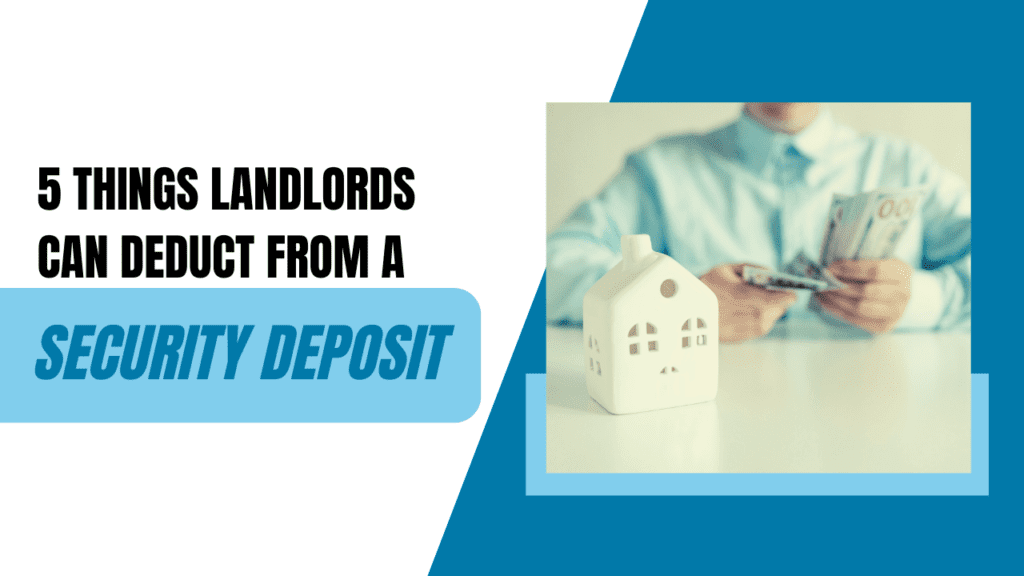
Security deposits are tricky for landlords all over the country, but in California, the laws are especially strict and extremely well-enforced.
San Diego landlords are required to follow some specific guidelines when they collect, hold, and ultimately return a tenant’s security deposit. You can find yourself making a potentially expensive mistake if you don’t understand the state’s security deposit laws or if you have a tenant who is disputing your claims of damage.
The rental property owner or property manager is responsible for holding the security deposit, but it remains the tenant’s money until the end of the lease term. You cannot spend it on a whim and you do not want it to mingle with your personal funds.
At the end of the lease term, you’ll have to determine how much of that deposit the tenant is getting back.
The reasons that you might keep the deposit are clear and you need to document that your withholding of any security deposit funds is justified.
We’re spending some time in this blog talking about five reasons that San Diego landlords can deduct money from a security deposit. We’re also going to remind you of some pretty serious dos and don’ts when it comes to California’s security deposit law.
Let’s take a look at why you might be able to keep some (or all) of the tenant’s money.
1. Using a San Diego Security Deposit for Unpaid Rent
You can use some or all of your tenant’s security deposit to cover any unpaid rent. You can apply it to an overdue account. There are several situations in which you may need to do this.
Maybe your tenant missed a payment one month and then never really got caught up. Perhaps you did not move towards and eviction – or even if you did – the tenant is leaving now, and you have that security deposit. You can use it to pay for the rent that was not paid previously.
Perhaps your tenant made a partial payments one month, leaving an overdue balance. The security deposit can be used to bring the account current after the tenant leaves. You never want the tenant to miss a month, but sometimes it happens. The security deposit is there to be applied for any outstanding money that is owed to you.
It’s not necessarily a good idea to let your tenants know that their deposit can and will be used when a month of rent is missed. There’s no good reason to make it easy for them to miss a payment. Don’t use the security deposit to manage payments or to stand in for the last month’s rent. Collect the rent every month as you normally do and enforce your lease agreement. But, if the end of the lease arrives and the tenant has moved out owing you back rent, you are entitled to the security deposit.
2. Applying the Security Deposit When the Lease is Broken
Using the deposit to pay for rent when tenants break the lease and leave the property suddenly and without notice is also permissible. The deposit, in this case, can make up for the income you’ve lost.
There are some specific things you and your tenant need to do when a lease is broken. It’s about much more than simply using the deposit. You need to make sure they take all of their belongings with them, and you’ll want them to understand their financial responsibilities for a broken lease. You’ll have to mitigate those costs by finding a new tenant quickly. However, you can use the security deposit when your tenant disappears with a chunk of the lease left.
3. Deducting the Cost of Repairs to a San Diego Rental Home
Property damage is always the responsibility of your tenant.
Once the tenants have moved out of your San Diego rental property, you’ll need to go inside and conduct a full inspection of the empty home. Take photos so you can document any damage or potential charges to that security deposit.
Here’s an important distinction: damage can be deducted, but wear and tear cannot be deducted. It’s critical that you understand the difference.
Sometimes, furniture will leave scuff marks on walls and floors. That’s not damage.
Wear and tear is the general deterioration that any property takes on during a residency. Small nail holes happen when pictures are hung. Carpet gets worn in high traffic areas. That’s not fair game when you are thinking about the security deposit. You need to pay for those repairs yourself.
Damage to the property and caused by the tenant, however, can be paid for out of the security deposit. This will go beyond wear and tear. It will be the result of abuse, misuse, or neglect. Large holes in the walls, cabinet doors dangling from their hinges, and huge tears or stains in carpet could be considered damage. Sometimes, it’s accidental. But it’s still damage.
The security deposit can be charged for tenant damage as long as you have the proper documentation to prove the property didn’t look like that when your tenants moved in. This is one area where most disputes between landlords and tenants are likely to happen. It underscores the need for solid proof. Have move-in and move-out condition reports that clearly demonstrate the tenant’s damage.
4. Cleaning Costs are Covered by Security Deposits
You can charge the security deposit for the cleaning fees you’ll have to pay, but make sure your lease agreement reflects this. Make sure your tenants know to expect it, too. Clear communication and a sharing of cleaning expectations will reduce the chance of conflict.
As soon as you receive your tenant’s notice to vacate, send instructions with very specific cleaning requirements so they’ll understand what they’re responsible for. You can expect tenants to return the property in a condition that’s as clean as it was when they moved in. Again – your move-in condition report will document what a clean rental home looks like.
If the tenants move out and you find that there’s trash left behind or not everything has been moved out, you will have to pay to have that stuff hauled out so you can make the rental home appealing to new tenants. The security deposit can help cover any cleaning costs that should have been your tenant’s responsibility.
Collect invoices and receipts so you deduct exactly the amount that was paid to clean the property or haul personal belongings.
5. Restoration Costs in San Diego Rental Properties
It’s a bit different from damage, and it’s not exactly cleaning. But, suppose your tenant painted the bedroom walls purple and did not re-paint before they left?
You cannot rent out a home that has purple walls. You’ll have to re-paint. That’s a restoration cost that you can charge to your tenant’s security deposit.
It’s not permissible to charge for restoration that’s the product of normal wear and tear. But when something has been altered in your property and needs to be restored to its original condition, your tenants are responsible for that. Make sure your lease prohibits the changing of paint colors, appliances, and other functions within the home.
Returning a San Diego Security Deposit
Now that you know why you can withhold a tenant’s security deposit, you need to understand the timeframe with which you must return it.
That timeframe is 21 days. You have 21 days from the tenant’s move-out to return the security deposit and/or a disposition letter.
Send any remaining security deposit that is owed to them and if you made deductions, make sure there’s an itemized list of what you withheld and why. You’ll need accounting that reflects the unpaid late fees you might have charged to the deposit as well as any damage that was fixed in the home.
If you’re not able to make all the necessary repairs within those 21 days, you have to send a Good Faith Statement with an estimate of what those repairs will cost. This isn’t generally necessary, especially if you have a good team of vendors who can make your repairs quickly.
Additional Security Deposit Tips
Here are some additional tips to making the security deposit collection and return easy:
- There are limits to what you can collect. The maximum amount California landlords can charge as a security deposit is the equivalent of two months’ rent for unfurnished residential properties and the equivalent of three months’ rent for furnished properties.
- There is no requirement that you pay interest on a security deposit in San Diego.
- Security deposits in California are always refundable. California law prohibits charging non-refundable deposits.
- Going to court for a security deposit claim can be costly. If the tenants win their case, you can be ordered to return the full amount of the deposit plus the equivalent of three months’ rent.
 We’d love to help you manage the collection or return of your tenant’s security deposit. If you’re not sure of what you can deduct for, please contact us at Chase Pacific Property Management & Real Estate Services. Count on us to provide all your San Diego property management answers.
We’d love to help you manage the collection or return of your tenant’s security deposit. If you’re not sure of what you can deduct for, please contact us at Chase Pacific Property Management & Real Estate Services. Count on us to provide all your San Diego property management answers.
